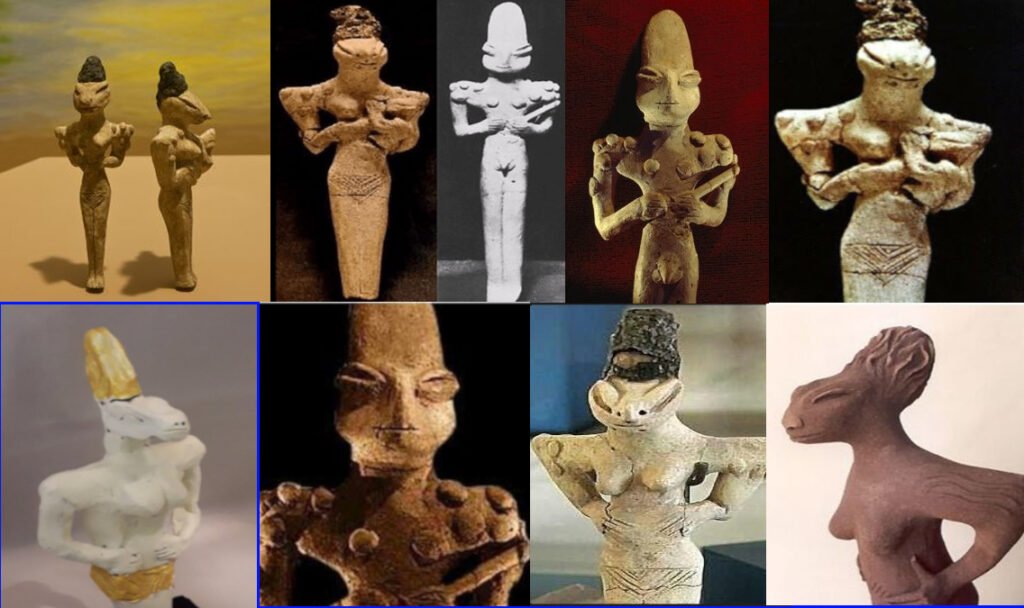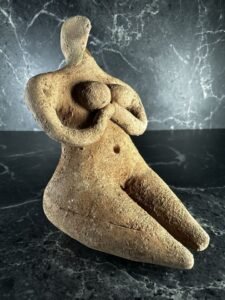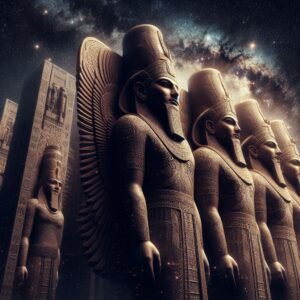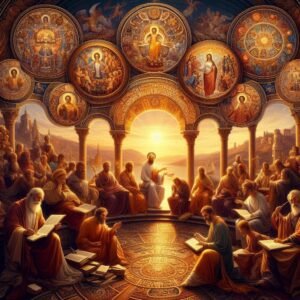
Ubaid Lizardmen – Archaeological Art
The Ubaid Culture
The Ubaid culture is an important prehistoric culture in the ancient Near East, particularly in Mesopotamia, which laid the foundation for later civilizations such as the Sumerians. The Ubaid period (approximately 6500 to 3800 BCE) is known for its distinctive archaeological features, including pottery, settlements, and early forms of social organization. It marks the period before the rise of the well-known Sumerian civilization and is considered a precursor to the urbanized societies of southern Mesopotamia.
The Ubaid period is generally placed between 6500 BCE and 3800 BCE, with Ubaid I (the earliest phase) starting around 6500 BCE. The culture persisted for about 1,500 years, covering multiple phases (Ubaid I, II, III, IV) before transitioning into the Uruk period, which is the dawn of Sumerian civilization.
The Ubaid culture is primarily associated with southern Mesopotamia, particularly in areas around modern-day Iraq, but it also extended into parts of Syria, Kuwait, southwestern Iran, and even as far as the Persian Gulf.
Large Settlements: The Ubaid period is characterized by the development of settlements that grew in size, from small villages to larger towns. These settlements, such as Eridu, Umm al-Aqarib, and Tell Abada, began to show signs of increasing population density and complexity in their urban planning.
Mudbrick Structures: Ubaid buildings were mainly constructed from mudbrick, and some large public buildings, especially in sites like Eridu, have been identified as temples or administrative structures. These were often characterized by open courtyards, large rooms, and storage areas, suggesting that these communities were engaged in agriculture and trade.
Eridu: One of the most important Ubaid sites is Eridu, often referred to as one of the world’s earliest cities. It is believed that Eridu was the site of the earliest Sumerian temple to the god Enki (Ea in Akkadian), making it a major religious centre in Ubaid times. The site has yielded evidence of early temple structures, craft workshops, and residential areas.
Distinctive Pottery
Ubaid pottery is one of the most recognizable aspects of this culture. The pottery was typically decorated with simple geometric patterns and was often made using the potter’s wheel—a technological advance that made its first significant appearance during this period.
Ubaid ceramics included large, storage jars, bowls, and cups. These vessels were often used for storing food, liquids, and other essentials, suggesting a highly organized society with trade and storage systems in place.
Agriculture: The economy of the Ubaid culture was largely based on agriculture. Evidence of irrigation systems has been found, particularly in southern Mesopotamia, where the Ubaid people cultivated barley, wheat, lentils, and dates. They also raised livestock, such as cattle, goats, and sheep.
Crafts and Trade: The Ubaid people were skilled in craft production, especially in pottery, textiles, and metalworking (particularly copper). Trade networks likely existed between different Ubaid settlements and neighbouring regions, as indicated by the presence of non-local materials such as obsidian and turquoise.
Social Hierarchy: While there is still some debate, evidence from the Ubaid period suggests the emergence of social stratification. The large temple structures and evidence of elite burials suggest a hierarchical society with a growing priestly and possibly political elite.
Temples and Religious Practices: The Ubaid culture had a well-developed religious system, cantered around the worship of gods associated with the natural world. Eridu, in particular, was a major religious site and may have housed one of the earliest temples in Mesopotamia. The worship of Enki (god of water, knowledge, and crafts) at Eridu is significant, as Enki would later become one of the most important gods in the Sumerian pantheon.
Ritual Objects
Archaeological excavations have revealed many ritual objects, including figurines, altars, and statuettes of deities, often found in temple contexts. These suggest that the Ubaid people had a rich spiritual life cantered around natural forces and ancestral veneration.
Burial Practices: The Ubaid people practiced burial in a variety of ways, with evidence of simple graves to more elaborate tombs. Elite individuals were often buried with grave goods, including pottery, jewellery, and tools, indicating the value placed on the afterlife and the existence of a social hierarchy.
Cultural Legacy and Influence: The Ubaid culture is seen as a precursor to the rise of Sumerian civilization. Many of the social, religious, and technological advancements of the Ubaid period, including the use of the potter’s wheel, irrigation, trade networks, and temple architecture, continued to influence subsequent periods in Mesopotamian history.
The Sumerians are thought to have inherited many aspects of Ubaid culture, particularly in terms of religion and economic practices. The rise of writing and urbanization in the later Uruk period (starting around 4000 BCE) likely built upon the foundations laid by the Ubaid culture.
The Ubaid culture and its belief system, while not directly documented in the same way as later Mesopotamian religions, shows some early signs of spiritual and mythological practices that could be considered precursors to the more developed pantheon seen in later periods, such as the Anunnaki of Sumerian and Akkadian mythology.
Anunnaki
The Anunnaki were a group of deities in Sumerian, Akkadian, and Babylonian mythology, often believed to be the gods of heaven and earth. While there are no direct references to the Anunnaki in the Ubaid period—since written records were not yet developed—there are significant archaeological and symbolic clues that suggest a connection or evolutionary development between the Ubaid belief system and the later Anunnaki pantheon.
Early Religious Beliefs in the Ubaid Culture
The Ubaid people had a polytheistic belief system, with an evident focus on nature deities and ancestral spirits. Temples and ritual structures suggest that the gods were linked to water (such as Enki or Ea, later in Sumerian religion), the earth, and the natural elements.
Eridu, particularly, is often cited as one of the earliest religious centres, and archaeological evidence suggests that the gods worshipped there were closely tied to water and fertility, themes that resonate in the later Anunnaki myths, where gods such as Enki are associated with freshwater and the creation of humankind. Enki (in the later Sumerian pantheon) is associated with water, wisdom, and creation, roles that might have been foreshadowed in the Ubaid period, even if the precise deities are not directly named.
The Connection Between the Ubaid Religion and the Anunnaki Pantheon: The transition from Ubaid beliefs to later Sumerian religion, and the eventual development of the Anunnaki, can be viewed as an evolutionary process where early spiritual practices and concepts were expanded, synthesized, and formalized as Sumerian civilization progressed. Here’s how these connections might be seen:
- Cosmic Order and Divine Hierarchy: The Ubaid culture’s focus on the natural world and ritualistic practices around life-sustaining forces (like water and fertility) can be seen as an early form of a cosmic order in which gods played a central role in maintaining the balance and order of the universe—a key theme in later Sumerian religious texts.
- Continuity and Evolution from Ubaid to Sumerian Religion: Over time, as Sumerian civilization grew, the gods of the Ubaid period were likely reinterpreted, absorbed, or evolved into the larger Anunnaki pantheon. Many scholars view this as a continuum in which early Ubaid deities (such as water and fertility gods) laid the foundation for the more complex and personified gods of the Sumerian and Akkadian periods.
By the time of the Sumerian city-states, deities such as Anu, Enki, Enlil, and Inanna had emerged as the main figures in the Anunnaki pantheon, but their roles and functions still reflect the early spiritual and agricultural concerns of the Ubaid people. The Anunnaki were recast as divine rulers of the heavens and earth, controlling fate, natural forces, and cosmic order, which was an extension of earlier themes from the Ubaid period.
Lizard People Figurines
The “Lizard People” figurines: The “lizard people” figurines from the Ubaid culture are intriguing artifacts that have sparked speculation and debate among scholars and enthusiasts. These figurines, often described as anthropomorphic reptilian figures, have been found at several Ubaid archaeological sites, most notably at Eridu and other prominent Ubaid settlements in southern Mesopotamia.
While these figurines have been popularly associated with theories about extra-terrestrial life or mythological beings, it’s essential to approach them from an archaeological and cultural perspective to better understand their potential significance within the Ubaid belief system and broader ancient Mesopotamian religion.
What Are the “Lizard People” Figurines?
Appearance: These figurines typically depict humanoid figures with features that suggest a reptilian or amphibious appearance, such as scaly skin, elongated bodies, large eyes, and sometimes serpent-like elements. The figures are typically made of clay and are often small in size, making them suitable for ritual purposes or as votive offerings.
Materials and Distribution: Most of the known lizard-like figurines are made from clay, though some have been found with other materials, such as stone. They have been discovered at Ubaid-era sites like Eridu, Tell Abada, and Tell el-Oueili, suggesting their relevance to the broader Ubaid cultural sphere.
Role in Ubaid Religion
Anthropomorphic Figures: The Ubaid period is known for its use of figurines representing gods, spirits, and possibly ancestors. These figurines often reflected the polytheistic and ritualistic nature of Ubaid religion, which focused on natural forces, fertility, ancestors, and spirits. In this context, the lizard-like figurines could have been symbolic of deities or spiritual entities related to water, fertility, or even underworld forces.
Reptilian Symbolism: Reptiles, especially snakes and lizards, have been long associated with fertility, regeneration, and protection in various ancient cultures. The serpent, for example, was often viewed as a symbol of life cycles, transformation, and renewal, potentially linking these figurines to fertility or underworld gods, as well as their role in protecting or guarding sacred spaces.
Water and Fertility: In Mesopotamian mythology, water and fertility gods were often depicted with amphibious or reptilian traits. For example, the god Enki, associated with water and wisdom, had associations with serpents or dragons in later Mesopotamian myths. The lizard-like figurines could, therefore, represent early, less formalized depictions of these fertility or water deities before they were fully developed in the more complex pantheons of later periods.
Serpents and Gods: The serpent has long been a symbol in Near Eastern religious symbolism, often associated with creation (as in Tiamat in Babylonian mythology, a dragon-like goddess of chaos) and life-giving forces. Given the lizard figurines’ similarities to serpents, they might represent such forces, emphasizing the importance of water and fertility in the Ubaid worldview.
Shamanic and Spiritual Significance: Some scholars have proposed that these figurines could have had a shamanic or spiritual significance. Shamanic figures often feature hybrid or animalistic traits, symbolizing the connection between humans and the spiritual world. If these figurines were indeed ritual objects, they might represent a connection to spiritual beings or protective spirits that helped bridge the human and divine worlds.
In the context of Ubaid rituals, the lizard figurines might have been used as offerings to the gods or ancestors, intended to ensure fertility, protect the community, or mark significant rites of passage.
Extra-terrestrial Theories: While mainstream archaeology does not support theories involving extra-terrestrial beings, the lizard people figurines have inspired some modern speculative theories suggesting that they might depict alien or extra-terrestrial beings, particularly those associated with the Anunnaki or similar mythological figures in later Mesopotamian cultures.
These theories draw upon the reptilian appearance of the figurines and often link them to popular cultural ideas about ancient astronauts or the idea that extra-terrestrial beings influenced early human development. However, there is no archaeological evidence to suggest that the Ubaid culture had any contact with aliens, and such ideas are generally regarded as speculative and non-scientific.
Possible Symbolic Interpretations
Water Deities: Given the important role of water in the Ubaid period (particularly in irrigation and agriculture), the lizard could symbolize creatures connected to water, such as serpents or fish, which were often fertility symbols in early cultures.
Guardians or Protectors: The reptilian figures may have been seen as guardians or protectors, with the ability to keep the spiritual realm or ritual space safe. Snakes, in particular, are often associated with protection in various ancient mythologies (e.g., the serpent in the Garden of Eden).
Transformation and Renewal: Reptiles, especially lizards, are symbols of transformation due to their ability to shed their skin. This might have connected them to beliefs around rebirth, resurrection, and renewal—key themes in agricultural societies that depend on cycles of life and death for crops.
The Ubaid culture marks a pivotal time in the development of ancient Mesopotamia. It provides evidence of early urbanization, religious practices, and technological advances that laid the groundwork for later civilizations like the Sumerians. Its importance is not just in the advances it made in areas like agriculture, pottery, and settlement building, but also in the spiritual and societal structures that influenced the emerging Sumerian state. The Ubaid culture represents the beginning of a long evolutionary process toward the complex societies that would dominate the ancient world for millennia.
Subscribe to our post updates - Don't miss a thing!!







